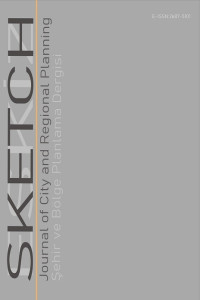Nijerya - Osun Eyaleti Ayedaade Yerel Yönetim Bölgesi Kırsal Topluluklarda Kadınların Yerel Pazarlara Seyahat Davranışı
Bu çalışma, Nijerya’da bulunan Osun Eyaleti'nin Ayedaade Yerel Yönetim Bölgesindeki bazı kırsal topluluklarda kadınların yerel pazarlara erişilebilirliğini incelemektedir. Bu araştırma için hem birincil hem de ikincil verilerden oluşan üç veri seti kullanılmıştır. İlk veri seti, cinsiyet kompozisyonu, eğitim seviyesi ve kişisel ulaşım araçlarına sahip olma gibi kırsal kesimde yaşayanların sosyo-ekonomik özelliklerine odaklanmaktadır. İkinci veri seti, yerel pazara gitmek için kat edilen mesafe, en çok kullanılan ulaşım şekli, ortalama seyahat süresi ve bir hafta içinde pazara gitme sıklığı gibi özellikleri dikkate alarak kırsal nüfusun yerel pazarlara seyahat modeline odaklanmaktadır. Son veri seti ise, kadınların bölgedeki yerel pazar merkezlerine erişim kısıtlamasına dayanmaktadır. Verileri analiz etmek için betimleyici ve çıkarımsal istatistik yöntemler kullanılmıştır. Bulgular, inceleme alanında Olufi merkez pazarında tarımsal ürünlerin ve az sayıda mamul malın ticaretinin yapıldığını göstermektedir. Kadınların %60'ından fazlası mallarını pazarlara taşımak için toplu taşıma hizmetlerini kullanmaktadır. Kırsal topluluklardaki kadınların %30'u pazarlara yürüyerek erişmekte ve ticari faaliyetlerde bulunmak için kilometrelerce yol kat etmektedir. Ayedaade Yerel Yönetimi’nin kırsal bölgesindeki pazarlara ulaşım biçimlerinde cinsiyet farklılıkları gözlemlenmektedir. Kırsal nüfusun çoğu, bölgedeki ulaşım hizmetlerinin seyrek çalışması nedeniyle tarımsal ürünlerinin transit olarak azaldığını iddia etmektedir. Bu nedenle çalışma, kadınların pazarlara erişimini ve Nijerya'nın kırsal bölgelerindeki diğer üretim faaliyetlerine katılımını artırmak için Nijerya'daki kırsal topluluklara yönelik sübvanse edilmiş toplum temelli ulaşım hizmetleri sağlanmasını önermektedir.
Anahtar Kelimeler:
Kadın, Erişilebilirlik, Kalkınma, Devlet, Planlama
Travel Behaviour of Women to Markets in Rural Communities in Ayedaade Local Government Area of Osun State
This study examined the accessibility of women to markets in some rural communities in Ayedaade Local Government Area of Osun State. Both primary and secondary data were utilised for this research. Three sets of data were required. The first set of data focused on the socio-economic characteristics of rural dwellers with emphasis on gender composition, level of education and possession of personal means of transportation. The second data required focused on the travel pattern of rural population to markets taking into account attributes such as distance travelled, mode of transportation mostly used, average travel time and frequency of trip to market in a week. The last category of data elicited was based on constraint of women to access market centres in the region. Descriptive and inferential statistics were employed to analyse the data. Findings reveal that agricultural products and few manufactured goods are traded at Olufi central market in the study area. More than 60% of women relied on public transport services to convey their goods to markets. 30% of women in the rural communities trekked to markets and travelled several kilometres to engage in commercial activities. There is gender variation on transport mode to markets in the rural region of Ayedaade Local Government. Many of the rural population claimed that their agricultural produce decayed on transit because of infrequent operation of the transport services in the region. The study therefore recommends that there is need to provide community based transport services at subsidized rate for rural communities in Nigeria so as to enhance the accessibility of women to markets and participate in other productive activities in the rural areas of Nigeria.
Keywords:
Women, Accessibility, Development, Government, Planning,
___
- Adetunji, M. A. 2003. “Geographical Analysis of Rural Transport and Accessibility in Ayeedaade Local Government Area of Osun State.” Unpublished M.Sc. Thesis, The Department of Geography, Obafemi Awolowo University, Ile-Ife.
- Adetunji M. A., and O. Aloba. 2018. “Analysis of the Distribution Pattern and Accessibility of Students to Secondary Educational Facilities in Lokoja, Kogi State, Nigeria.” Journal of Analele Universităţii din Oradea -Seria Geografie, XXVIII (1): 113-124.
- Astrop, A.; C. Palmer, D. Maunder, and D. M. Babu. 1996. “The Urban Travel Behaviour and Constraints of Low Income Households and Females in Pune, India.” In National Conference on Women’s Travel Issues, Baltimore, Maryland, USA, 23 - 26 October, 1996. Transport Research Laboratory, Crowthorne Berkshire United Kingdom. Working Paper PA3206/96. Available at: https://assets.publishing.service.gov.uk/media/5cdd30ac40f0b63816dc765c/1_644_PA3206_1996.pdf
- Dawson, J., and I. Barwell. 1993. Roads Are Not Enough: New Perspectives on Rural Transport Planning in Developing Countries. London: Intermediate Technology Publications.
- Dey, T., A. K. Pathak, and N. K. Baghmar. 2017. “Geospatial Analysis of Rural Weekly Markets: A Case Study of Bametara District of Chhattisgarh, India.” IOSR Journal of Humanities and Social Science, 22(5) Ver.II (May 2017): 45-53. http://www.iosrjournals.org/iosr-jhss/papers/Vol.%2022%20Issue5/Version-2/G2205024553.pdf
- Donnges, C., G. Edmonds, and B. Johannessen. 2007. Rural Road Maintenance - Sustaining the Benefit of Improved Access. Bangkok: International Labour Organization. https://www.ilo.org/wcmsp5/groups/public/---asia/---ro-bangkok/documents/publication/wcms_bk_pb_226_en.pdf
- Ellis, S. 1996. "The Economics of the Provision of Rural Transport Services." Ph.D. thesis. Cranfield University, U.K.
- Ellis, S. 1997. Key Issues in Rural Transport in Developing Countries. TLR Report 260. Berkshire: Transport Research Laboratory. https://assets.publishing.service.gov.uk/media/57a08db540f0b652dd001afe/TRL260.pdf
- Ferreira, F., D. M. Jolliffe, and E. B. Prydz. 2015. “The international poverty line has just been raised to $1.90 a day, but global poverty is basically unchanged. How is that even possible?” World Bank Blogs. https://blogs.worldbank.org/developmenttalk/international-poverty-line-has-just-been-raised-190-day-global-poverty-basically-unchanged-how-even
- Peters, D. 2013. Gender and Sustainable Urban Mobility. Thematic Study Prepared for Global Report on Human Settlements 2013. http://civitas.eu/sites/default/files/unhabitat_gender_surbanmobilitlity_0.pdf
- Pucher, J. 2009. “Cycling and Walking for All New Yorkers: Path to Improved Public Health.” Key note address for Fit City Conference, New York.
- Starkey, P., S. Ellis, J. Hine, and A. Ternell. 2002. Improving Rural Mobility : Options for Developing Motorized and Nonmotorized Transport in Rural Areas. World Bank Technical Paper no. 525. Washington: World Bank.
- Qualtrics. n.d. “What is factor analysis and how does it simplify research findings?” Accessed September 1, 2019. https://www.qualtrics.com/experience-management/research/factor-analysis/
- Tracey-White, J. D. 1995. Retail Markets Planning Guide. FAO Agricultural Services Bulletin 121. http://www.fao.org/3/V8390E/V8390E00.htm#Contents
- World Bank. 2014. World Bank on poverty in Nigeria. Poverty and Transportation: A way forward.
- Başlangıç: 2019
- Yayıncı: Mersin Üniversitesi
Sayıdaki Diğer Makaleler
Kent Kimliğinin Değişim Sürecini Geleneksel Çarşılar Üzerinden Düşünmek: Antakya-Uzun Çarşı Örneği
Konya Kent Merkezinde Taşıt Öncelikli Bir Uygulamanın İncelenmesi
Mehmet Çağlar MEŞHUR, Sinan LEVEND
Türkiye’de Sektörel Kayma ve Değişimin İller Düzeyinde Analizi; 2010-2016
